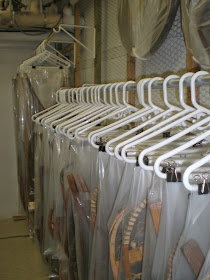The pair of gloves to be mounted had been worn to Abraham Lincoln's funeral on April 19, 1865 in Washington, DC by Robert Van Valkenburgh, a United States Congressman from New York and a Union Army officer.
The gloves are Paris made, as indicated from a stamp that appears inside one glove. They have been owned by the New York State Military Museum for many years and had been in a museum display in the early half of last century. For their upcoming exhibition, the New York State Millitary Museum wanted them again to be included in a short-term display. These 150+ year old gloves are made of fine thin leather, and both gloves together are quite light in weight.
After some humidification, a mount was created where one glove was palm down and the other was palm up. The gloves were quite stiff and misshaped from being wrapped and stored flat. Holes were present from a previous mounting method. The once black color of the outside of the leather had begun to powder and flake, mainly along the fold lines. Due to their fragility, a mount using magnets was created.
Once the shape of the gloves were determined, an internal form using Nomex was created for the fingers and palm for each glove. The thumb was supported separately. Attached to the Nomex were stitched two "L" brackets. They were positioned to support two of the fingers (image below).
 |
| The "L" brackets were selected to also support the fingers, as well as the palm of the glove |
 |
| Nomex layer with the attached steel brackets, also covered with foiled-paper tape. |
The brackets were both stitched with button hole thread (top photo above) and covered with foiled paper tape (directly above). The edges of the brackets were outlined with Volara framing tape in order to cushion the hard edges of the steel bracket. This was to be the side that faced the mount. The visible side of either glove was carefully padded out with layers of 1/4" Volara foam.
 |
| Internal support and the Glove |
Block shaped, 1/2"x3/8"x1/8", N42 Neodynimium rare earth magnets were used and secured to the mount. I have begun to think that magnets should be secured to the mount rather than incorporated with the artifact. For one, the mount can be reused, and having the magnet positioned in place could potentially be useful. Where as if installed in the artifact's internal structure, the magnet might stay there. With the cost of rare earth magnets increasing, and also with the unknown long-term effects, magnets kept within artifacts might be ill advised. Also, keeping an "active device" such as a magnet inside the artifact may cause inadvertent harm. What I mean is that we at SAC often speak of the "one-mindedness" of magnets. Magnets are always "on", and they will jump to a receiving metal as quickly as possible. If you did not know that an artifact had a magnet inside of it you could place it on or near something you actually do not want it to magnetically attach to.
 |
| Magnets glued to the Plexiglas and covered with foiled-paper tape. |
 |
| Positioned magnets with the Volara layer. Thin Volara was added over the magnets to fill the recess. |
 |
| Before the show fabric has been placed on the volara, but here is how the gloves will be positioned when they are displayed. |
In each of the papers I have published, or any of the presentations I have given, I talk about magnetic systems as being a three part system; 1) the strength of the magnet, 2) the ferromagnetic material and 3) the gap. As a means to begin to clearly illustrate my system to others, a form of language to describe the system is necessary. How do we begin to think about and write the three parts of a system? Below is my attempt to begin a discussion. The mount description is in brackets and begins with the bottom most layer first. The artifact is listed in italics and the internal structure within the artifact follows within the braces (aka squiggly brackets).
1. The position of the magnet is indicated by an asterisk. The grade and size of the magnet is in parentheses and follows the asterisk: *(grade, shape, size)
2. The ferromagnetic material, is underlined, it's gauge and/or thickness follows in parentheses.
3. The gap layers are in bold.
[Plexiglas, *(N42, block-1/2"x3/8"x1/8"), foil paper tape, Volara tape, show cover fabric] artifact (thin calf leather), {foil paper tape, steel bracket (1/16" thickness), Nomex}
Is this word diagram of mount layers (illustrated below) sufficiently explained so that another conservator or preparator can recreate this magnetic mount? What part of it is not understandable? How does this need to be changed?
 |
| Cross section of magnetic mount for gloves. |
Gwen Spicer is a textile conservator in private practice. Spicer Art Conservation specializes in textile conservation, object conservation, and the conservation of works on paper. Gwen's innovative treatment and mounting of flags and textiles is unrivaled. Her current research focuses on the use of rare earth magnets in conservation treatments. To contact her, please visit her website.
Learn more about magnets and their many uses in the new publications Magnetic Mounting Systems for Museums and Cultural Institutions. Available for purchase at www.spicerart.com/magnetbook.











